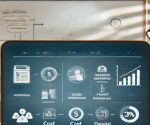Working Capital is a crucial financial metric that measures a company’s operational efficiency and short-term financial health. It represents the difference between a company’s current assets and current liabilities. In simple terms, it shows whether a company has enough short-term assets to cover its short-term liabilities. A positive working capital indicates that a company can pay off its short-term debts, while negative working capital suggests potential liquidity issues. Working capital is essential for day-to-day operations, including purchasing inventory, paying employees, and managing other short-term financial obligations.
What is Working Capital?
Working capital is the capital that a business uses in its day-to-day trading operations. It is derived by subtracting a company’s current liabilities from its current assets. The result reflects the company’s short-term financial health and its ability to pay off its short-term debts. If a company has more current assets than liabilities, it has a positive working capital, which is a good sign of financial stability and liquidity. On the other hand, if current liabilities exceed current assets, the business might struggle to meet its obligations, which could indicate liquidity problems.
Formula for Working Capital
The formula for calculating working capital is simple:
Working Capital = Current Assets – Current Liabilities
- Current Assets: These are assets that are expected to be converted into cash or used up within one year, such as cash, accounts receivable, and inventory.
- Current Liabilities: These are financial obligations that need to be settled within one year, such as accounts payable, short-term loans, and other short-term debts.
Importance of Working Capital
- Liquidity: A company needs sufficient working capital to ensure it can meet its short-term financial obligations.
- Operational Efficiency: Adequate working capital enables a company to maintain smooth operations without interruptions in production or supply.
- Financial Health: Positive working capital signals good financial health, while negative working capital may indicate financial distress.
Working Capital Formula
The working capital formula helps businesses calculate the amount of funds available for their day-to-day operations. It is an essential tool for financial analysis and planning.
Formula:
Working Capital = Current Assets – Current Liabilities
Components:
- Current Assets:
- Cash and cash equivalents: Money that can be quickly accessed.
- Accounts receivable: Money owed to the company by customers.
- Inventory: Goods and raw materials that are ready for sale or use.
- Prepaid expenses: Payments made for services or goods to be received in the future.
- Current Liabilities:
- Accounts payable: Money owed to suppliers and vendors.
- Short-term debt: Loans or obligations due within a year.
- Accrued expenses: Costs incurred but not yet paid (e.g., wages, utilities).
Example
If a company has $500,000 in current assets and $300,000 in current liabilities, the working capital will be:
Working Capital = $500,000 – $300,000 = $200,000
This means the company has $200,000 available to cover its short-term liabilities and finance day-to-day operations.
Interpreting Working Capital
- Positive Working Capital: Indicates that a company can comfortably pay its short-term debts and invest in its operations.
- Negative Working Capital: Suggests that the company might struggle to meet its short-term obligations, potentially leading to financial difficulties or insolvency.
Difference Between Fixed Capital and Working Capital
Fixed capital and working capital are two essential concepts in business finance, but they serve different purposes. Here’s a comparison:
| Aspect | Fixed Capital | Working Capital |
| Definition | Capital used for long-term investments in assets like machinery, buildings, and equipment. | Capital used for day-to-day operations, covering short-term financial obligations. |
| Purpose | To fund the acquisition of fixed assets that will benefit the business over a long period. | To ensure the business can meet its short-term liabilities and keep operations running smoothly. |
| Nature | Long-term investment. | Short-term financial resource. |
| Source | Typically raised through long-term financing such as loans, equity, or retained earnings. | Funded by current assets such as cash or receivables. |
| Impact on Cash Flow | Does not affect day-to-day cash flow directly. | Directly impacts daily cash flow and liquidity. |
| Examples | Machinery, land, buildings, and equipment. | Inventory, accounts receivable, cash, and short-term debts. |
Key Differences
- Fixed capital is invested in long-term assets that will depreciate over time, such as buildings, land, or equipment.
- Working capital is used for the everyday running of the business, such as paying suppliers and employees, purchasing raw materials, and managing cash flow.
The main difference lies in the time horizon: fixed capital supports long-term business growth, while working capital ensures that day-to-day operations are funded.
Types of Working Capital
There are various types of working capital that reflect the specific needs and financial health of a business. Understanding the different types can help a business make better financial decisions and maintain operational stability.
1. Permanent Working Capital
- This refers to the minimum amount of capital required to keep the business running in the long term. It represents the core level of working capital that a company needs to maintain daily operations.
- Permanent working capital is often stable and changes only gradually over time as the business expands or contracts.
2. Temporary Working Capital
- This is the additional working capital needed to manage fluctuations in business operations, such as seasonal demand, changes in production, or unanticipated costs.
- Temporary working capital may increase during periods of high sales or production and decrease during off-seasons.
3. Gross Working Capital
- Gross working capital refers to the total value of a company’s current assets, including cash, accounts receivable, and inventory.
- It does not account for the company’s liabilities, giving a broad view of available capital.
4. Net Working Capital
- Net working capital is the difference between a company’s current assets and current liabilities. It provides a clearer picture of a company’s short-term liquidity position and ability to cover its financial obligations.
- Formula: Net Working Capital = Current Assets – Current Liabilities.
5. Negative Working Capital
- Negative working capital occurs when a company’s current liabilities exceed its current assets, indicating potential liquidity issues.
- It can be a warning sign of financial trouble if it persists over time.
6. Positive Working Capital
- Positive working capital means a company has more current assets than current liabilities, which is generally a sign of good financial health.
- It allows the business to manage its daily operations effectively without relying on external financing.
Working Capital Example
To understand how working capital works in a real-world scenario, let’s look at an example:
Imagine a company that has:
- Current assets: $400,000 (cash, accounts receivable, inventory)
- Current liabilities: $250,000 (accounts payable, short-term debt)
Working Capital = Current Assets – Current Liabilities Working Capital = $400,000 – $250,000 = $150,000
This means the company has $150,000 available to cover its short-term obligations and maintain smooth operations. The positive working capital indicates that the company is financially stable in the short term and can cover its operational expenses and debts.
Seasonal Impact on Working Capital
If this company faces higher sales in certain months (say, during the holiday season), its working capital might temporarily rise due to an increase in accounts receivable and inventory. Conversely, during slow periods, working capital may decrease.
Conclusion
Working capital is an essential indicator of a company’s liquidity and ability to meet its short-term obligations. It plays a vital role in ensuring that day-to-day operations run smoothly without financial disruptions. Understanding working capital and its components, such as current assets and current liabilities, is crucial for effective business management. Maintaining a positive working capital is essential for financial stability, whereas a negative working capital could signal potential issues. By managing working capital efficiently, businesses can ensure their short-term operational needs are met, allowing them to focus on long-term growth.
Working Capital FAQs
What is the formula for working capital?
The formula for working capital is:
Working Capital = Current Assets – Current Liabilities
What is the difference between fixed capital and working capital?
Fixed capital is used for long-term investments in assets like machinery and buildings, while working capital is used for day-to-day business operations.
What are the types of working capital?
The main types of working capital are permanent working capital, temporary working capital, gross working capital, net working capital, and positive or negative working capital.
Can a business operate with negative working capital?
Operating with negative working capital is risky, as it means the business may not have enough assets to cover its short-term liabilities, which can lead to liquidity issues.
How does working capital impact business operations?
Working capital impacts a business’s ability to manage day-to-day expenses, pay employees, purchase inventory, and settle short-term debts, ensuring smooth operational flow.


